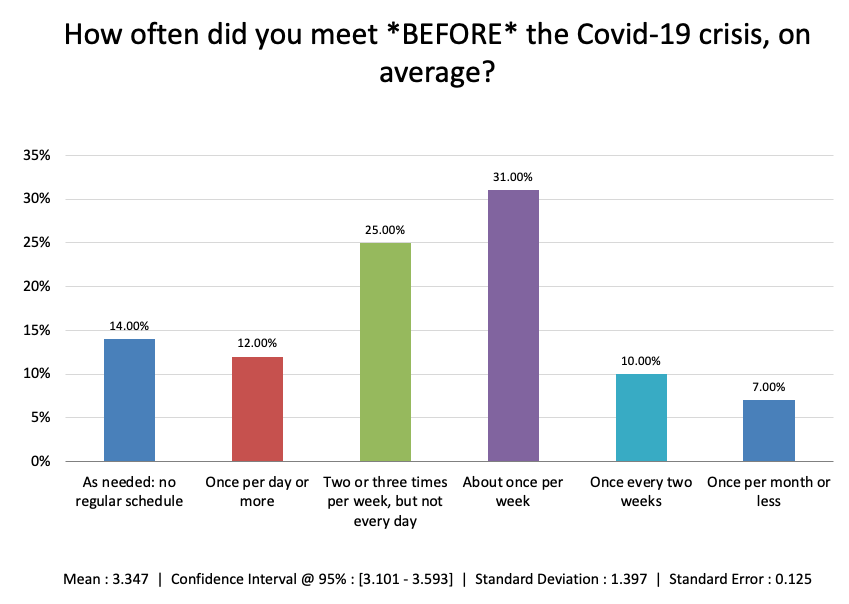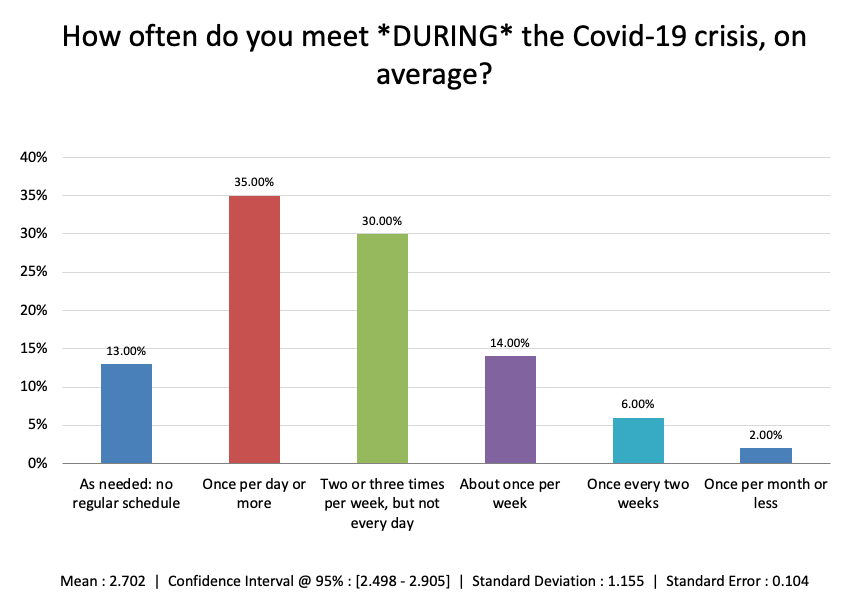Survey Results: How often do teams meet during a crisis? (Updated July 2020)
How often should your team meet, and how has that changed in response to the Covid-19 pandemic/economic upheaval? We collected data from teams around the globe to find out!
Research Background
This isn’t a question researchers can easily answer, because the answer depends on so many factors.
When we’ve looked at this question in the past, we had to rely on the published advice of business consultants and process experts, most of which was designed for teams meeting as part of their business-as-usual operations.
In our own research, we’ve talked with groups that meet just once per year because they must; it’s mandated by law. Otherwise they wouldn’t bother. We also spoke with one retired general who once had his teams run After Action Review meetings every 30 minutes during an especially intense training drill.
Finally, we know that in times of emergency, the group in charge of a coordinated emergency response will keep their communication channels open all day. Think of the war rooms you see in movies, or mission command, and you’ll know what we’re talking about.
These observations suggest that when you need to get people working together in a complex, rapidly evolving situation, you should meet a lot. We’ve recommended daily meetings at a minimum under these circumstances.
The Covid-19 pandemic created a complex, rapidly evolving situation for nearly every business all at once. So, to test our theory about what teams actually do in practice, we ran a short survey.
About the Survey
The survey consisted of just six quick questions, which we hoped would reveal any significant differences in the meeting frequency of senior vs. junior teams. Several hundred people replied in April 2020. (We hoped for more replies, but as you might guess, everyone was pretty distracted last April!)
Roughly half of the replies came from the U.S. and the other half from people working around the world. 54 percent came from for-profit companies, with the rest spread across government, education, non-profit, and healthcare.
Results: We Meet More in Times of Rapid Change and Crisis
The bottom line? Teams met more frequently during the onset of the Covid-19 crisis.


Meeting frequency increased for all sectors. What’s more: the frequency and regularity of meetings increased even for teams who rarely met at all before the crisis hit.
One surprise: we asked people about the kind of work they do, as we expected leadership teams to ramp up their meeting frequency more than delivery teams would.
We didn’t see that in this small sample size. In fact, none of the other questions we used to segment the results showed a different pattern.
Every team, in every line of work, from countries as diverse as Norway, Sudan, Thailand, and Brazil – all of them held more meetings as they worked together through the transition.
While the majority of teams made the same switch to a daily (or more) meeting frequency, they didn’t all make the transition with the same ease. We invited respondents to include a comment with their replies, and as these comments from the beginning of April show, the technology the team used had a big impact on the quality of all those meetings.
Because we are all working parents, now doubling as school teachers, our ability to communicate is less – despite the fact that we need to more! That said, we are doing more one on ones via the annoying whatsapp. Basically when we have a free moment we “chat” throughout the day… not very efficient.
Others discovered for the first time how productive online meetings can be.
Hi Zoom has helped us immensely – it has been easy to use and a vital to our continued support for our cluster of schools. We are using it all the time for leadership meetings, team meetings, meeting with other agencies, and casework meetings with school staff and whanaught. Amazing tool!
Establishing New Operating Rhythms
Once the initial crisis was understood, teams began to seek ways to reduce their meeting cadence. You can see that progression in these sample comments.
Here’s a comment from mid-April.
We reported out multiple times per day in the beginning HOT crisis phase. Now we are using the same format, but it’s less urgent. Feels much less effective.
This one is from late April.
We started by having a quick ‘stand up’ meeting every morning, but that quickly turned into longer conversations which threw our workdays off. We have since moved to our normal Monday morning meeting, but Tues-Fri we meet at 1:15 and it is a great way to recharge our batteries after lunch and gear up for the rest of the day.
As is this one, which describes how this team’s practice evolved in detail.
This response is for cabinet-level meetings at my college, which involve about a dozen administrative department heads and deans. In the beginning of the crisis, these were ad hoc, then we set a daily video call. This week we’re moving to a MWF schedule as we shift from crisis management to longer-term planning.
Our Takeaways: Lessons Learned for a More Adaptable, Resilient Future
We recently hosted a webinar with the founders of the Mission Critical Team Institute about what business teams can learn from the meeting practices of first responders and other mission-critical teams.
At the time, we didn’t have much data to rely on outside of the mission-critical context, nor did we have many recent stories from business teams. We certainly didn’t have any way to know how schools and churches and bands and all the many groups that have always relied on coming together in person would adapt to digital-only interaction.
Now we have more information about what worked well, and where people suffered (and continue to suffer). Going forward, we believe this mini-survey adds further support to the following recommendations:
- All teams, regardless of industry, should ensure they have access to location-agnostic communication systems. In 2020, videoconferencing, real-time chat, and a shared location for files became business necessities.
- Leadership should anticipate increasing meeting frequency during times of rapid change and develop meeting practices for use in those times. Build on what worked for you during the current crisis to create a meeting approach you can document and drill in the future.
- Using the fresh lessons learned, teams should set an intention regarding when and how to shift their meeting cadence going forward. This can help avoid some of the social awkwardness many teams face now as they try to figure out when or if it’s OK to meet less.
Of course, this survey supports just a few of the many lessons we’ve all learned about how business teams should best adapt their meetings during times of crisis.
What did your team learn about meeting during a crisis? What worked, and what didn’t?
Most importantly, what advice would you give teams facing a similar situation in the future?
Let us know in the comments, and we’ll work to help spread these great lessons where they can do the most good.



